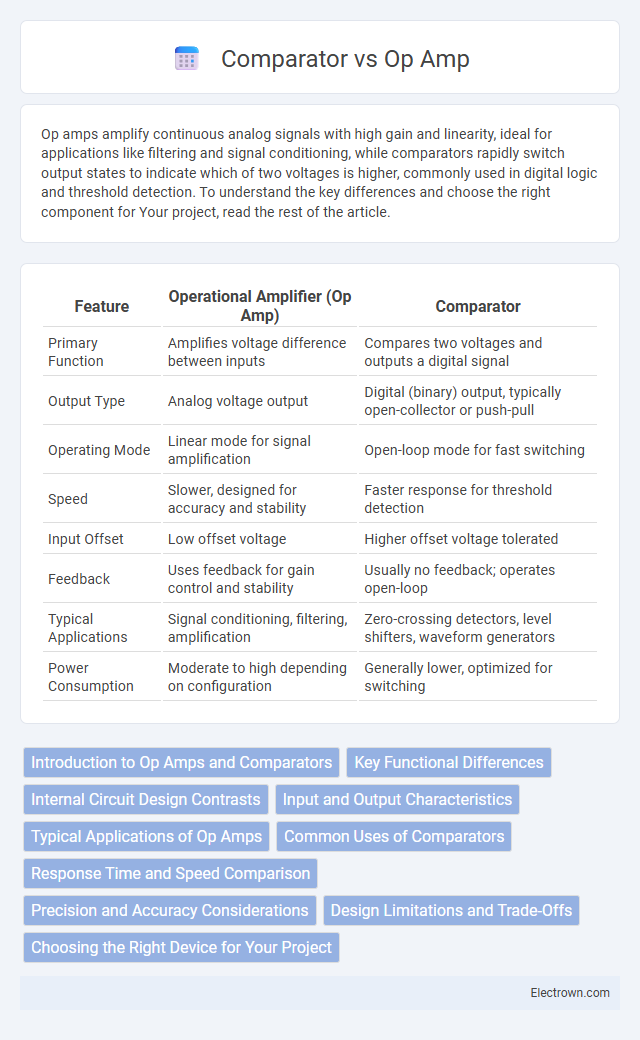Op amps amplify continuous analog signals with high gain and linearity, ideal for applications like filtering and signal conditioning, while comparators rapidly switch output states to indicate which of two voltages is higher, commonly used in digital logic and threshold detection. To understand the key differences and choose the right component for Your project, read the rest of the article.
Table of Comparison
| Feature | Operational Amplifier (Op Amp) | Comparator |
|---|---|---|
| Primary Function | Amplifies voltage difference between inputs | Compares two voltages and outputs a digital signal |
| Output Type | Analog voltage output | Digital (binary) output, typically open-collector or push-pull |
| Operating Mode | Linear mode for signal amplification | Open-loop mode for fast switching |
| Speed | Slower, designed for accuracy and stability | Faster response for threshold detection |
| Input Offset | Low offset voltage | Higher offset voltage tolerated |
| Feedback | Uses feedback for gain control and stability | Usually no feedback; operates open-loop |
| Typical Applications | Signal conditioning, filtering, amplification | Zero-crossing detectors, level shifters, waveform generators |
| Power Consumption | Moderate to high depending on configuration | Generally lower, optimized for switching |
Introduction to Op Amps and Comparators
Operational amplifiers (op amps) are versatile analog devices designed to amplify continuous voltage signals with high gain, commonly used in signal conditioning, filtering, and mathematical operations. Comparators are specialized circuits that compare two input voltages and output a digital signal indicating which input is higher, primarily utilized in threshold detection and switching applications. While both share similar internal architectures, op amps operate linearly with feedback to maintain output voltage proportionality, whereas comparators operate in an open-loop mode to provide rapid binary output transitions.
Key Functional Differences
Operational amplifiers (op amps) are designed for continuous linear amplification with high gain, primarily used in analog signal processing tasks such as filtering, integration, and voltage buffering. Comparators function as high-speed voltage level detectors that switch output states when the input voltage crosses a reference threshold, facilitating digital signal decision-making. Unlike comparators, op amps have feedback mechanisms to control gain and provide stable output within the linear region, whereas comparators operate without feedback to achieve rapid, binary output transitions.
Internal Circuit Design Contrasts
Op amps and comparators differ significantly in internal circuit design, with op amps optimized for linear amplification through differential input stages and gain stages that provide continuous output voltage. Comparators are constructed to rapidly switch output states with minimal delay, featuring a regenerative feedback mechanism for fast response but less emphasis on linearity. Understanding these contrasts helps you select the appropriate device for applications requiring precise analog signal processing or fast threshold detection.
Input and Output Characteristics
Op amps feature differential inputs with high input impedance and produce a continuous output voltage proportional to the input difference, ideal for amplification tasks. Comparators also have differential inputs but provide a binary output, switching sharply between voltage levels based on the input threshold. Your choice depends on whether you need precise analog amplification or fast digital signal detection.
Typical Applications of Op Amps
Op amps are commonly used in signal conditioning, filtering, and amplification tasks within audio equipment, sensor signal processing, and control systems. Their high gain and linear operation make them ideal for designing precision amplifiers, integrators, and active filters that enhance signal integrity. When selecting components for analog circuit design, understanding the typical applications of op amps ensures your project achieves accurate and stable performance.
Common Uses of Comparators
Comparators are commonly used in zero-crossing detectors, level shifters, and voltage threshold detectors for battery management systems. They play a critical role in analog-to-digital conversion by serving as basic decision-making elements in flash ADCs. Industrial automation and motor control applications rely on comparators to monitor signal levels and trigger digital outputs based on voltage comparisons.
Response Time and Speed Comparison
Op amps typically have slower response times compared to comparators, as they are designed for linear signal amplification rather than rapid switching. Comparators feature high-speed output stage architectures optimized for fast transitions, often achieving response times in nanoseconds, which is critical in applications requiring quick voltage level detection. Your choice between an op amp and a comparator should consider the required speed of signal processing, with comparators preferred for faster response and timing precision.
Precision and Accuracy Considerations
Op amps and comparators differ significantly in precision and accuracy, with op amps offering higher linearity and lower offset for precise analog signal amplification, making them suitable for applications requiring accurate voltage levels. Comparators prioritize speed and fast switching but exhibit greater input offset voltage and hysteresis, which can reduce accuracy in threshold detection. Understanding these precision characteristics helps you select the right device for tasks where exact voltage measurement or rapid digital decisions are critical.
Design Limitations and Trade-Offs
Operational amplifiers exhibit design limitations such as limited slew rate and gain-bandwidth product, which constrain their performance in high-speed comparator applications. Comparators are optimized for fast switching and have built-in hysteresis, but trade-offs include higher power consumption and reduced linearity compared to op amps. Selecting between an op amp and a comparator involves balancing speed, accuracy, power efficiency, and signal conditioning requirements.
Choosing the Right Device for Your Project
Selecting the right device between an operational amplifier (op amp) and a comparator depends on the specific application requirements such as speed, precision, and output behavior. Op amps are ideal for linear amplification, filtering, and analog signal conditioning due to their high input impedance and gain stability. Comparators excel in fast switching and digital interfacing tasks with open-drain outputs, making them suitable for threshold detection and square-wave generation.
op amp vs comparator Infographic

 electrown.com
electrown.com